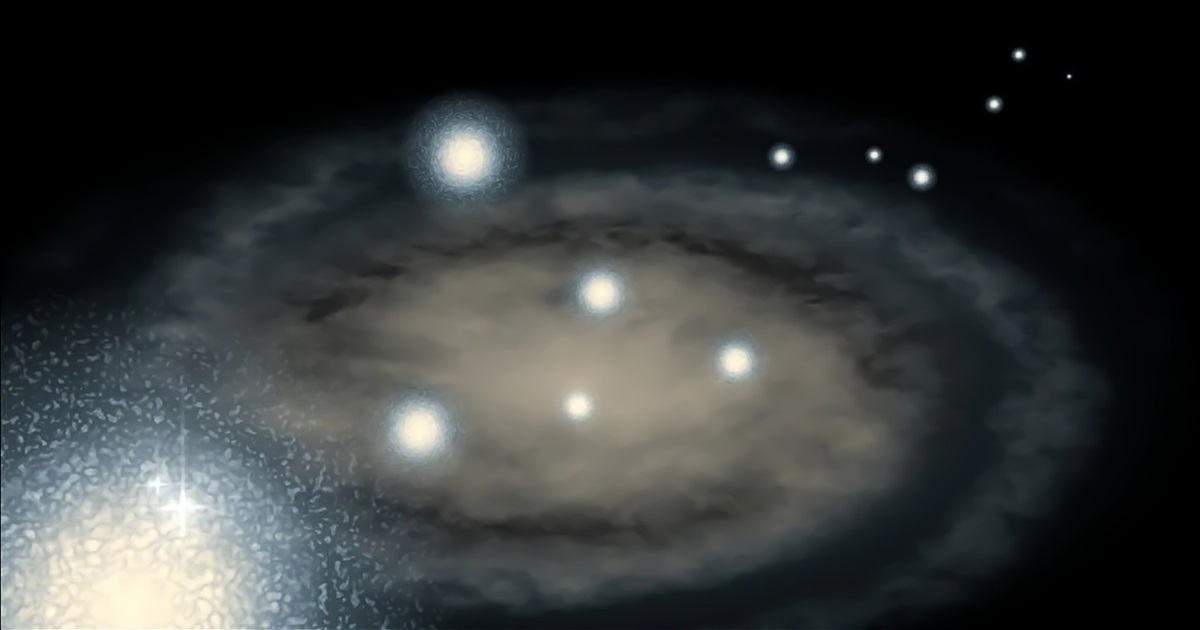Team led by Welsh scientists makes intergalactic cannibalism breakthrough

An international team of scientists led by an astrophysicist from Wales has shed new light on the life of galaxies and how they grow.
The team, led by Professor Geraint Lewis from the University of Sydney, discovered evidence the Andromeda galaxy is a cannibal growing through colossal intermittent feasts on smaller galaxies.
The research findings are based on the discovery of a structure of stars, known as globular clusters, in Andromeda that originated outside the galaxy. Professor Lewis, who was born in Neath and raised in the Dulais Valley, named this the Dulais Structure, drawn from the Welsh for black stream.
The Dulais Structure represents the leftovers of a colossal feeding event in the ‘recent’ past, a dark stream lit up by star clusters orbiting unlike any others in Andromeda.
The research team says the structure provides evidence that galaxies grow by ‘eating’ smaller systems, and the findings are at odds with a more sedate picture of galactic growth.
Grazing
“A few years ago, we discovered that in the far outskirts of Andromeda, there was a sign in the objects orbiting it that the galaxy hadn’t been grazing, but it had eaten large quantities in two distinct epochs,” said Professor Lewis.
“What this new result does is provide a clearer picture of how our local universe has come together – it is telling us that at least in one of the large galaxies, that there has been this sporadic feeding of small galaxies.”
“That then leads to the next question of, well, what was actually consumed? Because it doesn’t look like it was just one thing, it looks like it’s been a collection of things which are all being slowly torn apart,” Professor Lewis added.
“We’ve come to realise over the last few decades that galaxies grow by eating smaller systems – so little galaxies fall in, they get eaten – it’s galactic cannibalism.”
According to the research, Andromeda has the signatures of two major feeding events. Rough timescales indicate the most ‘recent’ feast took place sometime in the last 5 billion years, while the older feed was closer to 8-10 billion years ago.
The universe itself is 13.8 billion years old, meaning the two separate events may have taken place while matter in the universe was in closer proximity and more densely concentrated.
Astrophysicists like Professor Lewis are studying Andromeda to better understand how our own Milky Way has evolved.

It is unclear how the Milky Way itself has fed, but a picture is emerging in Andromeda with a clear signature – large feasts and growth spurts.
Given the Milky Way is a spiral galaxy of similar size, the research may be painting a picture of what our galaxy has done to reach its enormous size.
Consequences
“What we want to know is has the Milky Way done the same, or is it different? Both of those have interesting consequences for the overall picture of how galaxies form,” Professor Lewis said.
“We want to, at some level, come up with a more accurate clock to tell us when these events occurred because that’s one thing we need to include in our models of how galaxies evolve.”
Professor Lewis works at the Sydney Institute for Astronomy within the University of Sydney’s School of Physics and has published three cosmology-related books, the most recent of which is “Where did the universe come from? And other cosmic questions.”
He is not the first Welsh scientist with links to Andromeda. The Welsh engineer, businessman and amateur astronomer, Isaac Roberts, from Henllan, took the first photograph of the galaxy in 1888.
Support our Nation today
For the price of a cup of coffee a month you can help us create an independent, not-for-profit, national news service for the people of Wales, by the people of Wales.





Our scientists should give more Welsh names to things. When Bangor University in cooperation with CalTech and Aarhus Universities successfully teleported the quantum state of a whole beam of light Bangor should have named it something in Welsh (with no English alternative for the simple)
As it is, I look forward to the first English description of the Do-Lace Structure